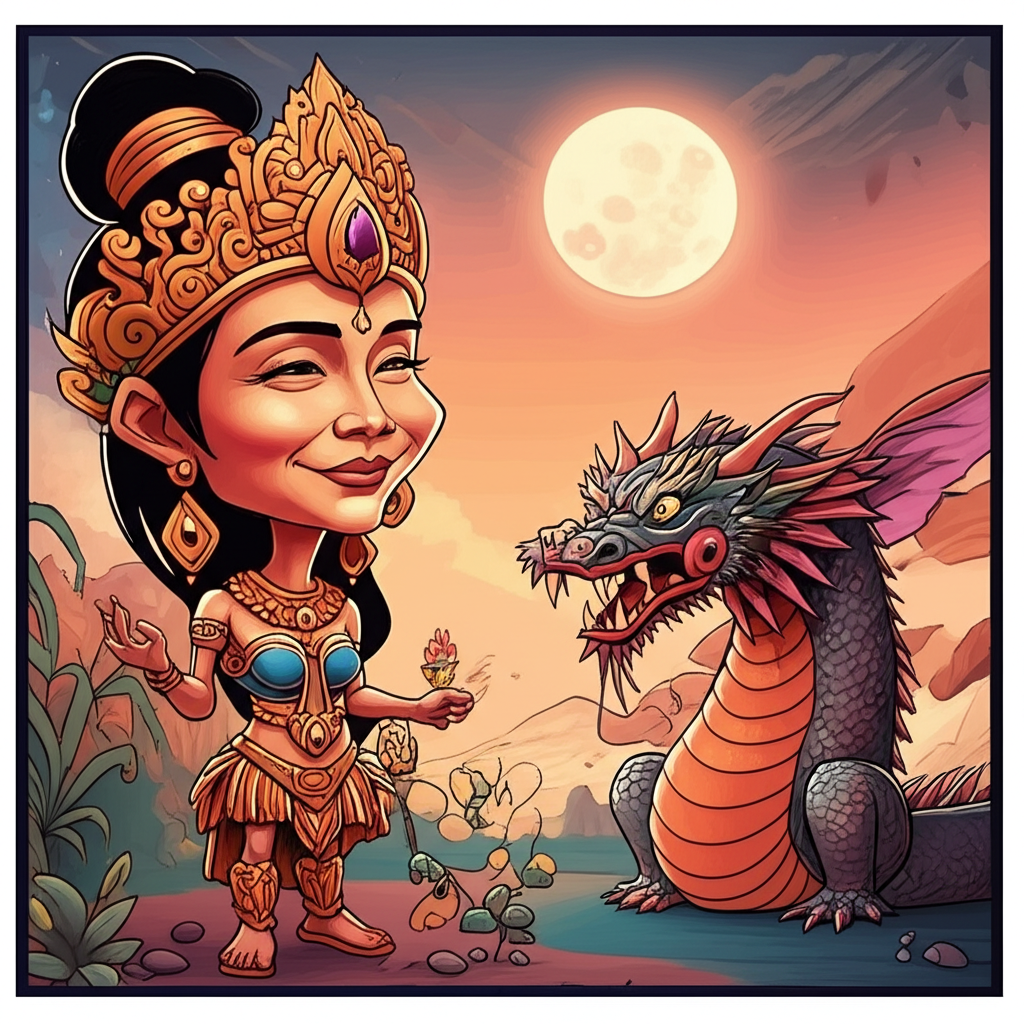
In the tapestry of Filipino folklore, woven from the whispers of the wind through ancient rice paddies and the murmur of waves against coral shores, lies the captivating myth of Anitun Tabu and the Trial of Bakunawa and the Moon. This is not a tale of historical record or divine decree, but rather a vibrant narrative passed down through generations by the wise elders of the indigenous peoples of the Philippines, particularly those inhabiting the islands of the Visayas. These stories, rich with metaphor and personification, served as a profound way for ancient communities to understand the celestial ballet above and the earthly dramas unfolding around them.
The genesis of such myths can be traced back to a time when the world was perceived as a place imbued with spirits and forces that governed the very essence of life. The pre-colonial Philippines was a society deeply connected to the rhythms of nature. Their lives were dictated by the cycles of the sun and moon, the bounty of the sea and land, and the ever-present threat of storms and natural disasters. In this context, the heavens were not merely empty space but a vast, populated realm where celestial beings engaged in grand narratives, mirroring the human struggles for balance, justice, and survival. The world was seen as a place of constant interplay between benevolent and malevolent forces, a perspective that allowed for the creation of complex mythological figures and epic sagas.
At the heart of this particular legend stands Anitun Tabu, often depicted as the formidable goddess of wind and rain. She is not a capricious deity, but a figure of immense power and authority, presiding over the atmospheric forces that could nurture or devastate the land. Her presence is felt in the gentle caress of a summer breeze and the terrifying roar of a typhoon. Symbolically, Anitun Tabu represents the raw, untamed power of nature, the unpredictable forces that shape the environment and, by extension, the lives of those who depend on it. Her name itself, often translated to mean "sacred wind," hints at her primal and awe-inspiring dominion.
The antagonist in this celestial drama is Bakunawa, a colossal serpent or dragon, often described as a creature of immense size that inhabits the depths of the ocean. Bakunawa is not simply a monster; it is a potent symbol of greed, chaos, and the insatiable appetite that can threaten to consume everything. Its scales are said to shimmer with an otherworldly luminescence, and its eyes are like molten gold. Bakunawa’s primary characteristic, and the source of its conflict, is its insatiable hunger, a hunger so profound that it is believed to cause eclipses by attempting to swallow the moon whole. This act is not mere destruction but a manifestation of a primal force seeking to dominate and disrupt the natural order.
The narrative of Anitun Tabu and the Trial of Bakunawa and the Moon unfolds as a dramatic cosmic event. In the ancient tales, the moon, a luminous entity often personified as a benevolent celestial being or a precious jewel in the night sky, would be threatened by the monstrous Bakunawa. Driven by an unquenchable hunger, Bakunawa would rise from its watery abyss, its massive form eclipsing the stars as it ascended towards the heavens. The people on Earth would witness this terrifying spectacle, their hearts filled with dread as the moon began to dim, a chilling prelude to its potential disappearance.
It was in these moments of celestial peril that Anitun Tabu would intervene. Her arrival would be heralded by the darkening of the skies and the rising of the winds. The ancient stories describe her summoning the fiercest gales and the most torrential rains, a symphony of atmospheric fury directed at the encroaching serpent. She would unleash her power not out of malice towards Bakunawa, but to protect the delicate balance of the cosmos and the world below. The trial, therefore, was not a formal court proceeding in the human sense, but a cosmic battle, a struggle for equilibrium between the forces of destruction and order.
The climax of the myth often involves Anitun Tabu, wielding the power of wind and rain, confronting Bakunawa. The winds would buffet the serpent, attempting to dislodge its grip on the moon, while the rains would lash against its scales, seeking to drive it back into the sea. The outcome of this trial was not always a definitive victory for Anitun Tabu, but a testament to the ongoing struggle. Sometimes, Bakunawa would be repelled, forced to retreat, and the moon would regain its full radiance, much to the relief of the watching world. At other times, the eclipse would persist for a period, a stark reminder of Bakunawa’s persistent threat. The community’s role in this narrative was often to participate in the ritualistic appeasement or invocation of Anitun Tabu, through songs, dances, or offerings, hoping to bolster her efforts and ensure the moon’s return.
The symbolism embedded within this myth is rich and multifaceted. Anitun Tabu, as the goddess of wind and rain, embodies the dual nature of natural forces – their capacity for both life-giving sustenance and destructive power. She represents the inherent resilience of nature and its ability to restore balance. Bakunawa, on the other hand, personifies the destructive impulses, the unchecked desires, and the chaotic forces that threaten to disrupt harmony. Its attempts to devour the moon can be seen as a metaphor for societal anxieties, the fear of the unknown, or the struggle against overwhelming challenges. The moon itself often symbolizes purity, guidance, and the passage of time, its dimming representing a period of darkness or crisis. The "trial" then becomes a representation of the constant human endeavor to maintain order in the face of chaos, to understand and appease the powerful forces of nature, and to find hope even in the darkest of times.
In the modern world, these ancient myths continue to resonate, albeit in different forms. The story of Bakunawa, in particular, has found new life in contemporary Filipino literature, art, and popular culture. It appears in children’s books, often reimagined as a fearsome yet ultimately defeatable dragon. In video games, Bakunawa might be a formidable boss, its legendary battle with the moon a thrilling encounter. In academic discourse, these myths are studied for their insights into the cultural values, beliefs, and worldview of ancient Filipino societies. They offer a window into how people made sense of their existence and their relationship with the natural world.
It is crucial to reiterate that the narrative of Anitun Tabu and the Trial of Bakunawa and the Moon is a product of ancient imagination and storytelling. It is a testament to the creative capacity of the human mind to weave tales that explain the inexplicable and explore profound themes. As Muslims, we recognize that the ultimate power and creation belong to Allah (God) alone, the true Creator and Sustainer of the heavens and the earth. These traditional stories, while culturally significant and artistically rich, are not to be mistaken for divine truth or religious doctrine.
In conclusion, the myth of Anitun Tabu and the Trial of Bakunawa and the Moon serves as a vibrant thread in the rich tapestry of Filipino cultural heritage. It is a story that speaks to the enduring human fascination with the cosmos, the power of nature, and the eternal struggle between order and chaos. Through these narratives, we gain a deeper appreciation for the imaginative spirit of our ancestors, their unique ways of understanding the world, and the enduring power of storytelling to connect us to our past and enrich our present. These tales, while not to be believed as factual, offer a valuable lens through which to understand the cultural evolution and the deep-seated human need for meaning and narrative in the grand unfolding of existence.





